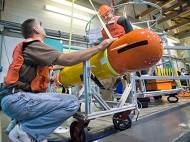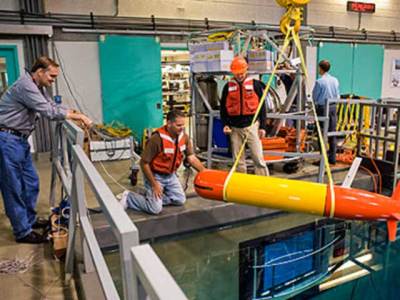MBARI Tethys AUV robot tested in the field
 Autonomous underwater vehicle (AUV) robot called Tethys spent most of October crisscrossing Monterey Bay as part of Monterey Bay Aquatic Research Institute (MBARI) CANON experiment where oceanographers used it to track patches of microscopic algae that were carried around the bay by currents. During this experiment, the robot showed that it could travel fast enough to buck the currents, but could also go into “hover mode” to drift with the currents when needed.
Autonomous underwater vehicle (AUV) robot called Tethys spent most of October crisscrossing Monterey Bay as part of Monterey Bay Aquatic Research Institute (MBARI) CANON experiment where oceanographers used it to track patches of microscopic algae that were carried around the bay by currents. During this experiment, the robot showed that it could travel fast enough to buck the currents, but could also go into “hover mode” to drift with the currents when needed.
In “high-speed mode” the robot can travel up to one meter per second (2.25 miles an hour) – about four times faster than most underwater gliders. However, it can also travel long distances at around half of that speed. In the field test, the AUV completed a four-day science run with plenty of battery power remaining, using relatively low-power rechargeable batteries. Based on these initial results, the researchers hope that the robot will eventually be able to travel from California to Hawaii by using high-power disposable batteries.
“In designing this AUV, we were actually trying to make a fundamental change in how we do oceanography. In the past, if we wanted to study something like an algal bloom, we could either put out a mooring and hope that the bloom would drift past it, or we could schedule a research cruise and hope that the bloom would happen while we were out on the ship. Tethys can travel to a spot in the ocean and ‘park’ there until something interesting happens. Once a bloom occurs, Tethys can move fast enough to follow the bloom and watch it evolve, the way a biologist on land might follow and study a herd of deer”, said Jim Bellingham, MBARI’s Chief Technologist, who has been designing AUVs for almost 20 years.
From the very beginning, Tethys was designed to be as energy efficient as possible. Its hull, motor, and propeller were computer designed and tested to minimize drag and maximize efficiency of propulsion. Like a fish, it can control its buoyancy and the angle at which it “swims” through the water. The robot also incorporates power-saving software which monitors what systems are being used, and turns off those systems that are not in use.
With its variable buoyancy system, Tethys can make itself neutrally buoyant. If the entire system went dead under these conditions, the robot would remain drifting somewhere below the surface, and could be very difficult to recover. To mitigate these risks, MBARI engineers designed numerous fail-safe systems into the robot, some of which have their own independent power supplies.
Most AUVs are programmed at the surface to follow a pre-set path through the water. Some can be reprogrammed via a satellite link when they come to the surface. Tethys takes this process further, and can make some decisions without human intervention. For example, during the CANON experiment, it was programmed to follow a course that would allow it to map the vertical and horizontal extent of algal blooms beneath the ocean surface.
Such internal decision making becomes increasingly important when robots operate for weeks or months at a time. As Bellingham put it, “We found that controlling the vehicle from shore via satellite was just too cumbersome. By the time the vehicle had seen a promising patch, reported it to us, and we had sent the vehicle back toward the center of the patch, the patch had moved. Also, controlling the robot 24/7 was very tiring for the human operators. We suspected, and now we know, that the long-term success of such research depends on the vehicle being able to carry all this out on its own.”
As with the energy efficiency software, having such sophisticated internal control software carries certain risks. As Bellingham put it, “You cannot predict exactly how the AUV will behave—that’s the whole point. But you still want to make sure that whatever it decides to do, nothing bad is going to happen to the vehicle.”
Bellingham hopes that this new AUV design will be small and inexpensive enough so that it can be used for a variety of ocean research and monitoring, and he also hopes to use two AUVs with different instruments in a single experiment, so that they can monitor different types of marine organisms simultaneously.










Leave your response!